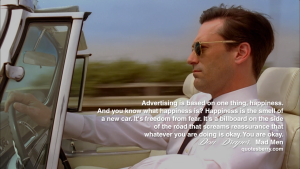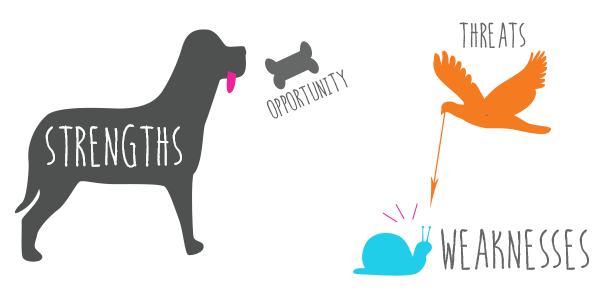While watching TV recently I was surprised to see that an Audi commercial (The drones. YouTube.) featured a driver using the car’s backup camera to escape from drones. I was surprised for two reasons. First, I am secretly scared of the idea of drones and picture Star Wars-like armies marching through the streets when I even hear the word and second, it seems that others are like me and that Audi thought they could somehow comfort potential drivers with the added safety feature of drone protection.
https://www.youtube.com/watch?v=vcV71liAMwc
In the first episode of Mad Men (“Smoke Gets in your Eyes”), Don Draper tells us that happiness is freedom from fear. Harkening back to CMGT510, Dr. Cody taught us that fear can be an element of persuasion used in emotional appeals in advertising. Maybe Don attended Dr. Cody’s class?
According to Jennifer Hicks (2015), “drones have gone mainstream” and are no longer restricted to the military but are used in many industries for many purposes. Audi must have read her post. Let’s imagine the positioning for branding an imaginary drone that we will name Buzz (to reflect the droning sound of a friendly bee) produced by Acme Drones for delivering mail using the formulaic structure provided in this week’s instructional materials:
For [target market] [brand name] is the [product/service description] that [benefit] / [reason why].
For [mail delivery] [Acme Buzz] is the [drone] that is the [quietest model] so as to [maintain peace and not disturb a neighborhood].
Well, you can see how hard this might be to nail down the clear unique selling point of such a product. But whether it’s a not so terrorizing drone or another, more marketable product, it would still need situational analysis which starts with a branding audit. Reflecting upon the elements of our imaginary drone, we could envision the following:
- Mission: To deliver mail in a timely, non-threatening way through any weather.
- Vision: To increase the efficiency of mail delivery and reduce costs
- Positioning: For [mail delivery] [Acme Buzz] is the [drone] that is the [quietest model] so as to [maintain peace and not disturb a neighborhood].
- Brand Image: Quiet, efficient, hardworking (like our Bee association) Note: this is not what is portrayed in the Audi commercial and would need consumer research
- Voice: Professional, soothing
- Company Name: Acme (This would have made a great Wiley coyote cartoon – but maybe I am now showing my age)
- Brand Architecture: Acme would have to determine if Buzz would use the umbrella Acme brand in promotion or stand on its own as only Buzz
- Logo: Imagine the word Buzz with a bumble bee entwined
- Visual Vocabulary: Like our bumble bee, yellow and black as colors and a simple font such as Gadugi
- Messaging: Quiet, friendly delivery option at any time of the day or night
- Tagline: Anywhere. Any time. Without a word.
- Brand Experience: Safe, Undisturbed, Friendly
My takeaway is that every product – including drones – needs to go through this and it should help the marketing team crystallize the unique selling proposition.
References:
Hicks, J. (2015, May 31). Innovative creative branding through drones. Forbes. Retrieved from http://www.forbes.com/sites/jenniferhicks/2015/05/31/innovative-creative-branding-through-drones/
“Smoke Gets in Your Eyes”. Mad Men. Lions Gate Entertainment. American Movie Channel. 19 July 2007. Television.
The drones. YouTube. Retrieved from https://www.youtube.com/watch?v=vcV71liAMwc




2 Responses to Situational Analysis: Branding drones